[Home Theater Network HDAV.com.cn] From the current mainstream three immersive three-dimensional sound speaker layout, including Dolby Atmos, Auro-3D and DTS: X, DTS: X layout is a two-layer structure, the ground Layer and ceiling layer, the layout of the ceiling layer is the most complicated among the three surround sound effects. According to DTS official data, the most one layout method can set the 17.2.13 channel speaker. Below I will talk about six key points suitable for the layout of speakers used in our general home environment, including 7.1.4 (Lh/Rh + Lhr/Rhr), 7.1.4 (Ltf/Rtf + Ltr/Rtr), 5.1. 4 (Lh/Rh + Lhr/Rhr), 5.1.4 (Ltf/Rtf + Ltr/Rtr), 5.1.2 (Lhs/Rhs or Ltm/Rtm), 5.1.2 (Lh/Rh).
7.1.4 (Lh/Rh + Lhr/Rhr) layout set 7 speakers on the ground floor, 1 subwoofer, 4 speakers on the ceiling layer
The first recommended layout is the speaker setting method of 7.1.4. It adopts two layers of ground and ceiling structure. In the layout analysis diagram, you can see that the central gray arrow part is the listening position, the white square is the ceiling speaker, and the black square. For ground speakers. There are two pointing angles involved, where Az represents the height of the human ear from the listening position to the horizontal tilt of each speaker, and El is the vertical tilt angle from the ground listening position to the speaker. The layout of the seven speakers on the ground is circular. The front two main speakers have an Az angle of 30 degrees from the listening position, a side circumference of 90 degrees, and a rear surround of 150 degrees. This layout setting is close to the ITU international standard. The ceiling speaker layer is composed of four speakers. The angle from the listening position is 45 degrees horizontally and 45 degrees vertically. It is square and the four speakers point to the listening position.

7.1.4 (Lh/Rh + Lhr/Rhr) layout analysis diagram
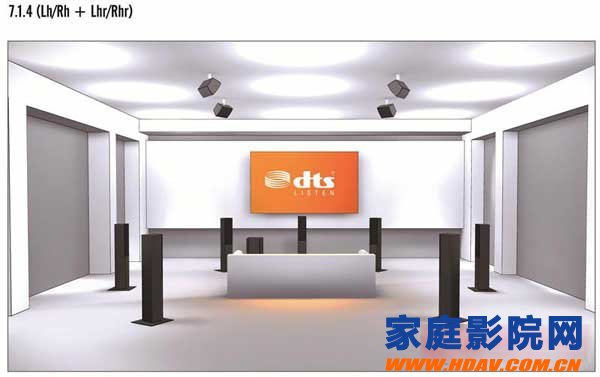
7.1.4 (Lh/Rh + Lhr/Rhr) system three-dimensional diagram
7.1.4 (Ltf/Rtf + Ltr/Rtr) layout set 7 speakers on the ground floor, 1 subwoofer, 4 speakers on the ceiling layer
The second recommended speaker setting method is also based on the structure of 7.1.4. It also uses a two-layer structure of ground and ceiling. The ground speaker layer is circular, each speaker points to the listening position, and the ceiling speakers are on the same level. However, unlike the 7.1.4 (Lh/Rh + Lhr/Rhr) layout described above, the four speakers of the ceiling do not point to the listening position, but to the ground, and the angle to the listening position is level 45, respectively. Degree, vertical is 60 degrees, and is square. This layout is mainly used for some custom-made ceiling speakers, and ceiling speakers that have no way to adjust the directivity. It is a flexible adjustment method that takes into account the actual installation problems.

7.1.4 (Ltf/Rtf + Ltr/Rtr) layout analysis diagram

7.1.4 (Ltf/Rtf + Ltr/Rtr) system three-dimensional diagram
5.1.4 (Lh/Rh + Lhr/Rhr) layout set 5 speakers on the ground floor, 1 subwoofer, 4 speakers on the ceiling layer
In the two speaker layouts mentioned above, there are 7 ground speakers, which require a total of 11.1 channels of AV amplifiers. In fact, mainstream and mid-range AV amplifiers usually have only 9.1 channels of speaker layout, so 5.1 The speaker layout of .4 is believed to get more applications. The layout of 5.1.4 is also divided into two types in DTS: X. Among them, the layout setting of 5.1.4 (Lh/Rh + Lhr/Rhr) is set on the ground floor with two main speakers in front and listening. The horizontal tilt of the position is 30 degrees, and the horizontal tilt angle of the two rear surround speakers is 110 degrees. The setting of the ceiling layer is that the front two horizontal inclination angles are 45 degrees, the rear side is 135 degrees, and the vertical inclination angle to the listening position is 45 degrees, and all the speakers are pointed above the listening position.

5.1.4 (Lh/Rh + Lhr/Rhr) layout analysis chart
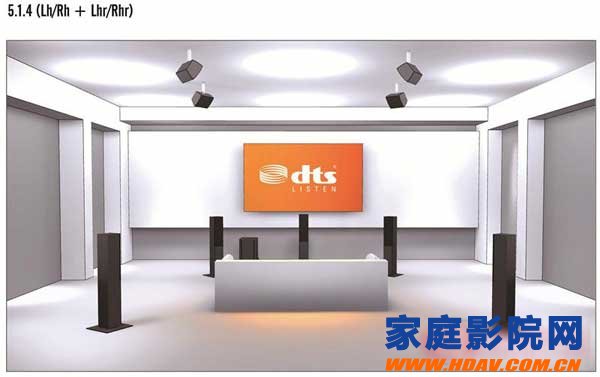
5.1.4 (Lh/Rh + Lhr/Rhr) system three-dimensional diagram
5.1.4 (Ltf/Rtf + Ltr/Rtr) layout set 5 speakers on the ground floor, 1 subwoofer, 4 speakers on the ceiling layer
The same as the previous two 7.1.4 systems, the 5.1.4 system layout also has two layout methods, the main difference is in the direction of the ceiling speaker, 5.1.4 (Ltf / Rtf + Ltr / Rtr) this is Pointing to the ground, it does not face the listening position as in 5.1.4 (Lh/Rh + Lhr/Rhr), while other speakers are set as follows: 5 ground speakers, all pointing to the listening position, the level of the front two main speakers The tilt angle is 30 degrees, and the horizontal tilt angle of the two surround speakers is 110 degrees. The upper sound field is composed of four speakers, centered on the listening position. The front two horizontal tilt angles are 45 degrees, the vertical tilt angle is 60 degrees, and the rear two are They are 135 degrees and 60 degrees respectively.
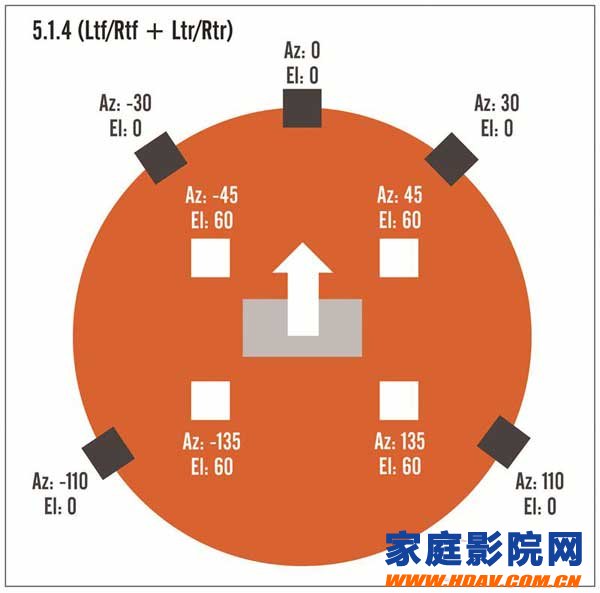
5.1.4 (Ltf/Rtf + Ltr/Rtr) layout analysis diagram
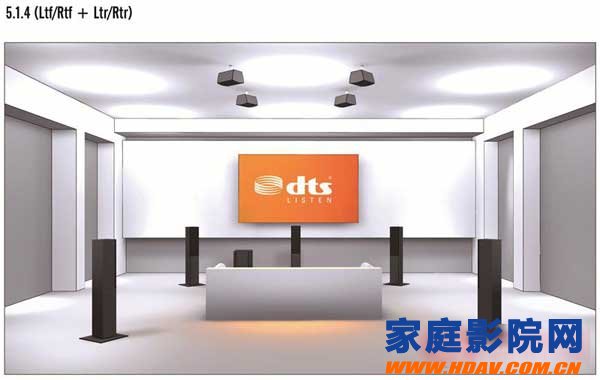
5 .1.4 (Ltf/Rtf + Ltr/Rtr) system 3D schematic
5.1.2 (Lhs/Rhs or Ltm/Rtm) layout set 5 speakers on the ground floor, 1 subwoofer, 2 speakers on the ceiling layer
Like Dolby Atmos, DTS: X's smallest surround sound box layout is 5.1.2, which is the distribution of the ground 5.1 system and the ceiling speakers. It only needs the low-end 7.1-channel AV amplifier to drive. The 5.1.2 speaker system also has two different layouts, of which 5.1.2 (Lhs/Rhs or Ltm/Rtm) is laid out as follows: the horizontal tilt of the two main speakers in front of the ground floor is 30 degrees. The rear surround angle is 110 degrees, and all the speakers point to the listening area; the ceiling layer has two speakers, which are located 90 degrees to the left and right sides of the listening position, and the speaker points to the listening position or the ground with a vertical angle of 45 degrees. This approach is very different from the 5.1.2 system of Dolby Atmos we have been exposed to before.

5.1.2 (Lhs/Rhs or Ltm/Rtm) layout analysis diagram
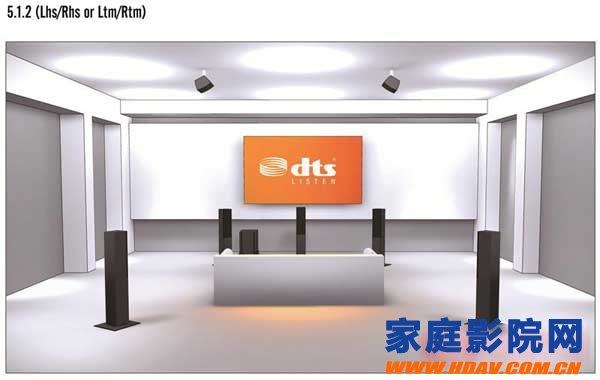
5.1.2 (Lhs/Rhs or Ltm/Rtm) System 3D Schematic
5.1.2 (Lh/Rh) layout setting 5 speakers on the ground floor, 1 subwoofer, 2 speakers on the ceiling layer
The last DTS recommended speaker layout setting is also the structure of 5.1.2, which is basically similar to the previous 5.1.2 (Lhs/Rhs or Ltm/Rtm). The difference between 5.1.2 (Lh/Rh) is that Only the ceiling and orientation of the ceiling speaker. In terms of position, the two ceiling speakers are placed in front of the listening position, with a horizontal inclination of 45 degrees and a vertical inclination of 45 degrees, all pointing to the listening position, not facing the ground. The layout of the ground floor is that the front two main speakers have a horizontal inclination of 30 degrees and a rear circumferential inclination of 110 degrees. All the speakers point to the listening area.
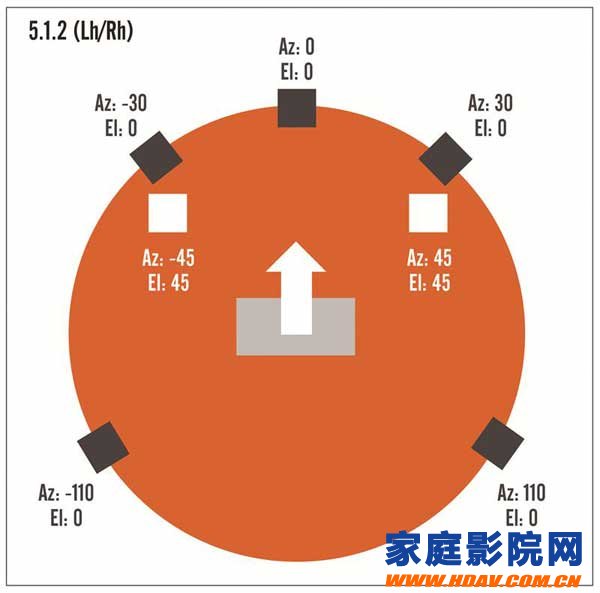
5.1.2 (Lh/Rh) layout analysis diagram
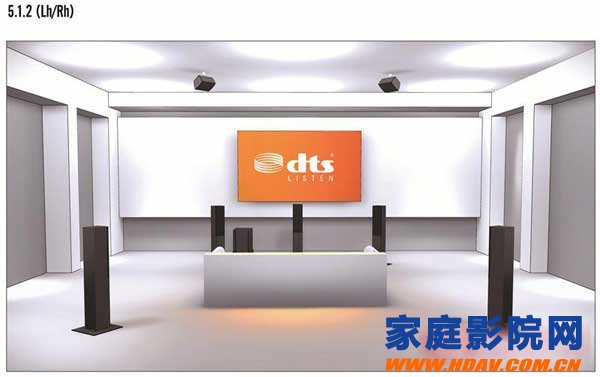
5.1.2 (Lh/Rh) system three-dimensional diagram

17.2.13 layout analysis diagram
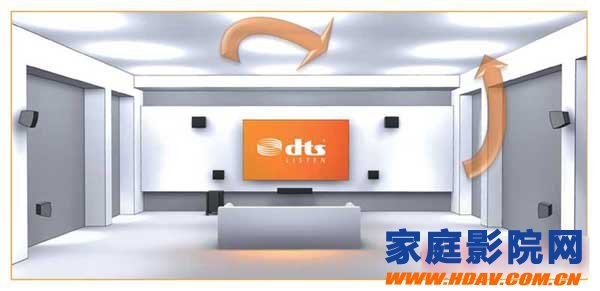
DTS: X is an immersive 3D sound that highlights the height of the sound field and the fluidity of the sound.

DTS: X has no concept of channel, you can hear different positioned object sounds in different speakers
Conclusion
The above two surround sound speaker layouts are DTS:X recommended for ordinary home users, allowing everyone to reflect DTS:X based on sound object positioning under relatively few speaker settings. Immersive 3D sound technology. And because DTS: X speaker layout is actually more free, the more speaker layout, the more detailed the sound, the more density and level, DTS: X also gives a 17.2.13 speaker layout There are two circular layouts on the upper layer, which are the upper sound field and the small sound field, and in the center of the ceiling sound field, that is, the listener's head is also set with a separate speaker, so that the listener can truly feel the movie sound from the top of the head. If you have a qualified enthusiast, you may wish to give it a try.
More fresh and fun home theater information, please pay attention to home theater network http:// (WeChat: cnhifi), the country's most influential home theater audio player interactive media website.
Engine Oil Seal,Diesel Engine Parts Oil Seal,Engine Fan Hub Seal Oil,Crankshaft Oil Seal
Chongqing LDJM Engine Parts Center , https://www.ckcummins.com